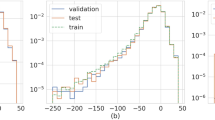Abstract
This work aims to predict moderate, intense, and super geomagnetic storms during the two recent solar cycles 23 and 24 encompassing the period 1996–2018 using an artificial neural network (ANN). Optimization of the neural network includes a choice of activation function, training function, learning function, hidden layers, hidden neurons, learning rate, and momentum constant. The results obtained by the present study show the ability of the ANN model to produce an accurate estimate of the probability appearance of moderate and intense storms of about 88.9%.




Similar content being viewed by others
References
R K Burton, R L McPherron and C T Russell J. Geophys. Res. 80 4204 (1975)
S Kugblenu, S Taguchi and T Okuzawa Earth Planets Space 51 307 (1999)
J A Lazzús, C H López-Caraballo, P Rojas, I Salfate, M Rivera and L Palma-Chilla J. Phys. Conf. Ser. 720 012001 (2016)
J Uwamahoro and J B Habarulema Earth Planets Space 66 95 (2014)
J Uwamahoro, L A McKinnell and J B Habarulema Ann. Geophys. 30 963 (2012)
N Srivastava Ann. Geophys. 23 2969 (2005)
Y Kamide et al. J. Geophys. Res. Space Phys. 103 17705 (1998)
Y M Wang, P Z Ye, S Wang, G P Zhou and J X Wang J. Geophys. Res. 107 1340 (2002)
J A Lazzús, P Vega, P Rojas and I Salfate Space Weather 15 1068 (2017)
A Lethy, M A El-Eraki, A Samy and H Adeebes Space Weather 16 1277 (2018)
D H Hathaway Living Rev. Sol. Phys. 7 1 (2010)
H Lundstedt, H Gleisner and P Wintoft Geophys. Res. Lett. 29 34 (2002)
H Lundstedt and P Wintoft Ann. Geophys. 12 19 (1994)
F Valach, M Revallo, J Bochnicek and P Hejda Space Weather 7 S04004 (2009)
M Dryer, Z Smith, C D Fry, W Sun, C S Deehr and S I Akasofu Space Weather 2 S09001 (2004)
G Singh and A K Singh J. Earth Syst. Sci. 125 899 (2016)
M Chandorkar, E Camporeale and S Wing Space Weather 15 1004 (2017)
M A Gruet, M Chandorkar, A Sicard and E Camporeale Space Weather 16 1882 (2018)
S B Xu, S Y Huang, Z G Yuan, X H Deng and K Jiang Astrophys J Suppl S 248 14 (2020)
G E Brueckner et al. Geophys. Res. Lett. 25 3019 (1998)
B Vrsnak, D Maricic, A L Stanger, A M Veronig, M Temmer and D Rosa Sol. Phys. 241 85 (2007)
E Robbrecht, D Berghmans and R A M Van der Linden Astrophys. J. 691 1222 (2009)
N Srivastava and P Venkatakrishnan J. Geophys. Res. 109 A10103 (2004)
W D Gonzalez and B T Tsurutani Planet. Space Sci. 35 1101 (1987)
E Echer, W D Gonzalez, B T Tsurutani and A L C Gonzalez J. Geophys. Res. 113 A05221 (2008)
I T Jolliffe Principal Component Analysis. (New York: Springer-Verlag) (2002)
M M Poulton Geophysics 67 979 (2002)
C Bishop Pattern Recognition and Machine Learning. (New York: Springer-Verlag) (2006)
S C Huang and Y F Huang IEEE Trans. Neural Netw. Learn. Syst 2 47 (1991)
G B Huang and H A Babri IEEE Trans. Neural Netw. Learn. Syst 9 224 (1998)
B Mirko and J Christian Geophysics 65 1032 (2000)
Acknowledgements
Acknowledgment has to be given to authors of the LASCO/SOHO catalog list of CMEs, available online at http://cdaw.gsfc.nasa.gov/CMElist which was used for the study. The work was also supported by the National Aeronautics and Space Administration for providing us the necessary data of the most significant flare, available online at http://hesperia.gsfc.nasa.gov/goes/goes event listings/goes Xray event list 2014.txt.
Author information
Authors and Affiliations
Corresponding author
Additional information
Publisher's Note
Springer Nature remains neutral with regard to jurisdictional claims in published maps and institutional affiliations.
Rights and permissions
About this article
Cite this article
Singh, P.K. Prediction of intensity of moderate and intense geomagnetic storms using artificial neural network during two complete solar cycles 23 and 24. Indian J Phys 96, 2235–2242 (2022). https://doi.org/10.1007/s12648-021-02192-0
Received:
Accepted:
Published:
Issue Date:
DOI: https://doi.org/10.1007/s12648-021-02192-0




